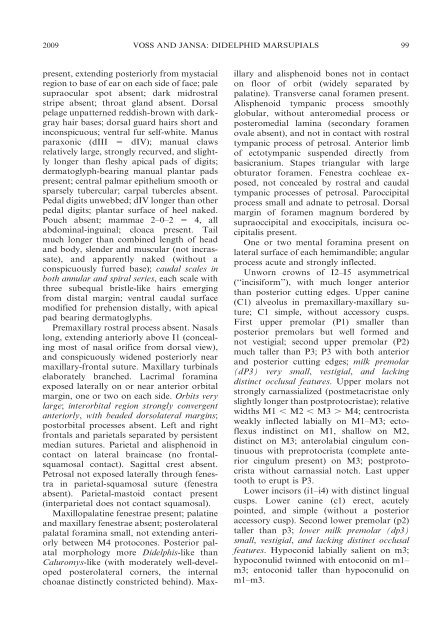phylogenetic relationships and classification of didelphid marsupials ...
phylogenetic relationships and classification of didelphid marsupials ...
phylogenetic relationships and classification of didelphid marsupials ...
Create successful ePaper yourself
Turn your PDF publications into a flip-book with our unique Google optimized e-Paper software.
2009 VOSS AND JANSA: DIDELPHID MARSUPIALS 99<br />
present, extending posteriorly from mystacial<br />
region to base <strong>of</strong> ear on each side <strong>of</strong> face; pale<br />
supraocular spot absent; dark midrostral<br />
stripe absent; throat gl<strong>and</strong> absent. Dorsal<br />
pelage unpatterned reddish-brown with darkgray<br />
hair bases; dorsal guard hairs short <strong>and</strong><br />
inconspicuous; ventral fur self-white. Manus<br />
paraxonic (dIII 5 dIV); manual claws<br />
relatively large, strongly recurved, <strong>and</strong> slightly<br />
longer than fleshy apical pads <strong>of</strong> digits;<br />
dermatoglyph-bearing manual plantar pads<br />
present; central palmar epithelium smooth or<br />
sparsely tubercular; carpal tubercles absent.<br />
Pedal digits unwebbed; dIV longer than other<br />
pedal digits; plantar surface <strong>of</strong> heel naked.<br />
Pouch absent; mammae 2–0–2 5 4, all<br />
abdominal-inguinal; cloaca present. Tail<br />
much longer than combined length <strong>of</strong> head<br />
<strong>and</strong> body, slender <strong>and</strong> muscular (not incrassate),<br />
<strong>and</strong> apparently naked (without a<br />
conspicuously furred base); caudal scales in<br />
both annular <strong>and</strong> spiral series, each scale with<br />
three subequal bristle-like hairs emerging<br />
from distal margin; ventral caudal surface<br />
modified for prehension distally, with apical<br />
pad bearing dermatoglyphs.<br />
Premaxillary rostral process absent. Nasals<br />
long, extending anteriorly above I1 (concealing<br />
most <strong>of</strong> nasal orifice from dorsal view),<br />
<strong>and</strong> conspicuously widened posteriorly near<br />
maxillary-frontal suture. Maxillary turbinals<br />
elaborately branched. Lacrimal foramina<br />
exposed laterally on or near anterior orbital<br />
margin, one or two on each side. Orbits very<br />
large; interorbital region strongly convergent<br />
anteriorly, with beaded dorsolateral margins;<br />
postorbital processes absent. Left <strong>and</strong> right<br />
frontals <strong>and</strong> parietals separated by persistent<br />
median sutures. Parietal <strong>and</strong> alisphenoid in<br />
contact on lateral braincase (no frontalsquamosal<br />
contact). Sagittal crest absent.<br />
Petrosal not exposed laterally through fenestra<br />
in parietal-squamosal suture (fenestra<br />
absent). Parietal-mastoid contact present<br />
(interparietal does not contact squamosal).<br />
Maxillopalatine fenestrae present; palatine<br />
<strong>and</strong> maxillary fenestrae absent; posterolateral<br />
palatal foramina small, not extending anteriorly<br />
between M4 protocones. Posterior palatal<br />
morphology more Didelphis-like than<br />
Caluromys-like (with moderately well-developed<br />
posterolateral corners, the internal<br />
choanae distinctly constricted behind). Max-<br />
illary <strong>and</strong> alisphenoid bones not in contact<br />
on floor <strong>of</strong> orbit (widely separated by<br />
palatine). Transverse canal foramen present.<br />
Alisphenoid tympanic process smoothly<br />
globular, without anteromedial process or<br />
posteromedial lamina (secondary foramen<br />
ovale absent), <strong>and</strong> not in contact with rostral<br />
tympanic process <strong>of</strong> petrosal. Anterior limb<br />
<strong>of</strong> ectotympanic suspended directly from<br />
basicranium. Stapes triangular with large<br />
obturator foramen. Fenestra cochleae exposed,<br />
not concealed by rostral <strong>and</strong> caudal<br />
tympanic processes <strong>of</strong> petrosal. Paroccipital<br />
process small <strong>and</strong> adnate to petrosal. Dorsal<br />
margin <strong>of</strong> foramen magnum bordered by<br />
supraoccipital <strong>and</strong> exoccipitals, incisura occipitalis<br />
present.<br />
One or two mental foramina present on<br />
lateral surface <strong>of</strong> each hemim<strong>and</strong>ible; angular<br />
process acute <strong>and</strong> strongly inflected.<br />
Unworn crowns <strong>of</strong> I2–I5 asymmetrical<br />
(‘‘incisiform’’), with much longer anterior<br />
than posterior cutting edges. Upper canine<br />
(C1) alveolus in premaxillary-maxillary suture;<br />
C1 simple, without accessory cusps.<br />
First upper premolar (P1) smaller than<br />
posterior premolars but well formed <strong>and</strong><br />
not vestigial; second upper premolar (P2)<br />
much taller than P3; P3 with both anterior<br />
<strong>and</strong> posterior cutting edges; milk premolar<br />
(dP3) very small, vestigial, <strong>and</strong> lacking<br />
distinct occlusal features. Upper molars not<br />
strongly carnassialized (postmetacristae only<br />
slightly longer than postprotocristae); relative<br />
widths M1 , M2 , M3 . M4; centrocrista<br />
weakly inflected labially on M1–M3; ect<strong>of</strong>lexus<br />
indistinct on M1, shallow on M2,<br />
distinct on M3; anterolabial cingulum continuous<br />
with preprotocrista (complete anterior<br />
cingulum present) on M3; postprotocrista<br />
without carnassial notch. Last upper<br />
tooth to erupt is P3.<br />
Lower incisors (i1–i4) with distinct lingual<br />
cusps. Lower canine (c1) erect, acutely<br />
pointed, <strong>and</strong> simple (without a posterior<br />
accessory cusp). Second lower premolar (p2)<br />
taller than p3; lower milk premolar (dp3)<br />
small, vestigial, <strong>and</strong> lacking distinct occlusal<br />
features. Hypoconid labially salient on m3;<br />
hypoconulid twinned with entoconid on m1–<br />
m3; entoconid taller than hypoconulid on<br />
m1–m3.

















